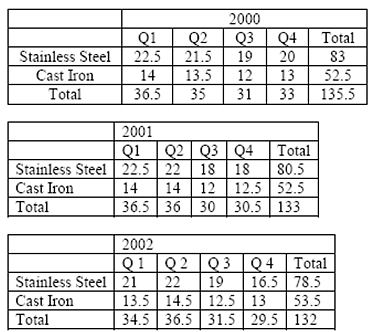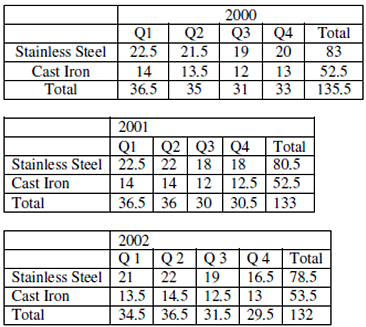CAT Practice Test- 1 (June 1) - CAT MCQ
30 Questions MCQ Test Daily Test for CAT Preparation - CAT Practice Test- 1 (June 1)
According to the information provided in the passage:
I. Classical musicians in the past had the advantage of knowing what lay ahead as they were walking on a path set-up by the predecessors.
II. For composers, the sharing of history that set-up the tradition of composing along certain lines is something that is no longer the case.
III. At some point of time, the past was the source of origin of music for composers.
II. For composers, the sharing of history that set-up the tradition of composing along certain lines is something that is no longer the case.
III. At some point of time, the past was the source of origin of music for composers.
The train track in the given passage is a/an:
I. Oxymoron
II. Hyperbole
III. Metaphor
IV. Analogy
Identify the ones which are apt in the given case.
II. Hyperbole
III. Metaphor
IV. Analogy
According to the author, causes and effects in the social world are
Which of the following statements about scientism is best supported by the passage?
As is used in the passage, the term ‘scientism’ can best be defined as
In the passage, the author is most concerned with doing which of the following?
According to the author, the habit of plundering the strangers:
Which of the following does not come under the aegis of capital already invested?
Which of the following may be called the main complaint of the author?
The author of the passage implies the beliefs of naturalists as:
I. Observed
II. Non-partisan
III. Corroborated
Each of the following is true as per the passage except:
With reference to each other, the beliefs of the naturalists and super-naturalists:
The tone and attitude exhibited by the author of the passage can be identified as:
Four sentences related to a topic are given below. Three of them can be put together to form a meaningful and coherent short paragraph. Identify the odd one out. Choose its number as your answer and key it in.
Four sentences related to a topic are given below. Three of them can be put together to form a meaningful and coherent short paragraph. Identify the odd one out. Choose its number as your answer and key it in.(numerical value)
- Being “all in” or “all out” are two unproductive ways of finding a work-life balance in a family business.
- Indeed, they can cause problems when it comes to succession or when boundaries cut across customer needs or reduce operational efficiencies.
- Neither alternative allows the family member room to sculpt a satisfying role in the family business system.
- Of course, finding a balance is difficult in a publicly-traded company, too, but in a family business the boundary between professional and personal lives is often fuzzy.
Four sentences related to a topic are given below. Three of them can be put together to form a meaningful and coherent short paragraph. Identify the odd one out. Choose its number as your answer and key it in. (numerical value)
- Smart businessmen aren't interested in putting their efforts into business plans dependant on laws which, not only haven't been passed yet, but haven't even been introduced.
- Smart Congressmen aren't interested in putting their efforts into introducing legislation to create industries that businessmen aren't even talking about yet.
- It would make a huge difference if someone capable of operating at that level, such as a really big investor or a Fortune 500 company, took the time to think carefully about the economics and realized how profitable owning land on the Moon could be and talked of the necessary legal eco-system.
- Of course, the Congress would give the idea much more credibility if they heard someone representing Boeing or Lockheed tell them that passing a land claims recognition law would lead to a serious privately funded space development effort but the problem, unfortunately, has been like the classic "which comes first: the chicken or the egg?"
Identify the most appropriate summary for the paragraph.
Of all the uncertainties in our halting economic recovery, the housing market may be the most confusing of all. At times, real estate seems to be in the early stages of a severe double dip. Home sales plunged in July, and some analysts are now predicting that the market will struggle for years, if not decades. Others argue that the worst is over. As Karl Case, the eminent real estate economist, recently wrote, “Buying a house now can make a lot of sense.” I can’t claim to clear up all the uncertainty. But I do want to suggest a framework for figuring out whether you lean bearish or less bearish: do you believe that housing is a luxury good and that societies spend more on it as they get richer?
Identify the most appropriate summary for the paragraph.
The man of science knows, in one aspect, that the world is not merely what it appears to be to our senses; he knows that earth and water are really the play of forces that manifest themselves to us as earth and water—how, we can but partially apprehend. Likewise the man who has his spiritual eyes open knows that the ultimate truth about earth and water lies in our apprehension of the eternal will which works in time and takes shape in the forces we realise under those aspects. This is not mere knowledge, as science is, but it is a preception of the soul by the soul. This does not lead us to power, as knowledge does, but it gives us joy, which is the product of the union of kindred things. The man whose acquaintance with the world does not lead him deeper than science leads him, will never understand what it is that the man with the spiritual vision finds in these natural phenomena. The water does not merely cleanse his limbs, but it purifies his heart; for it touches his soul. The earth does not merely hold his body, but it gladdens his mind; for its contact is more than a physical contact—it is a living presence.
Identify the most appropriate summary for the paragraph.
The year 2013 was one of the ten hottest on record. So was 2010. So were 2009, 2007, 2006, 2005, 2003, 2002, and 1998. Last year, with its polar vortex and biting winter, seemed to bring relief to North America. Except it also brought temperatures of over 120ºF to Australia, massive flooding to Malaysia, and the third harrowing year of drought to California. As it turns out, 2014 was the hottest single year since meteorologists started measuring in 1850. By now, we’ve raised the average global temperature a little less than one degree Celsius since the beginning of the industrial revolution. The best predictions suggest that we will raise it somewhere between four and six degrees by 2100. With the heat will also come side effects: fiercer and more frequent storms, droughts, acidifying oceans, melting glaciers, and the loss of species. And the bad news is, that’s not even the bad news. Each drought, each megastorm, each scorching summer puts a strain on the complex systems that provide us with water, food, and power and that keep disease and disorder at bay. These systems can often endure a single crisis—one Sandy, one Katrina. The problem is what happens when the Sandys and Katrinas start coming back to back, piling up on each other. That’s when the money runs out, the electricity goes off, and everyone starts wondering where to find water. If true catastrophe arrives, it will not come gradually but, as the historian Nils Gilman writes, “as a series of radical discontinuities—a series of bewildering ‘oh shit’ events.” Welcome to the future. Oh shit.
DIRECTIONS for the question: The five sentences (labelled 1,2,3,4, and 5) given in this question, when properly sequenced, form a coherent paragraph. Decide on the proper order for the sentence and key in this sequence of five numbers as your answer.
- ‘What kind of materials?’ The bank officer looked puzzled, as if this were some sort of new game whose rules he was not familiar with. He let me speak out of common respect for a University department head, but he was clearly lost.
- ‘What can I do for you, sir?’
- The Chittagong University branch of the Janata Bank was housed in a single square room. The manager, sitting at the back to the left, under a ceiling fan, greeted me politely and invited me to sit down.
- ‘Well, some make bamboo stools; others weave mats, or drive a rickshaw.... If they borrowed from a bank at commercial rates, they could sell their products on the open market and make a decent profit that would allow them to live.
- ‘The last time I borrowed from you was to finance the Three-Share Programme. Now I have a new proposal. I want you to lend money to the poor people in Jobra. The amount involved is very small. I have already-done it myself. I have lent $27 to forty-two people. There will be many more poor people who will need money. They need this money to carry on their work, to buy raw materials and supplies.’
DIRECTIONS for the question: The five sentences (labelled 1,2,3,4, and 5) given in this question, when properly sequenced, form a coherent paragraph. Decide on the proper order for the sentence and key in this sequence of five numbers as your answer.
- They simply followed the trail blazed by mainstream mortgage lenders in the 1980s.
- But that did not worry the subprime lenders.
- As a business model subprime lending worked beautifully – as long as interest rates stayed low, as long as people kept their jobs and as long as real estate prices continued to rise.
- Instead of putting their own money at risk, they pocketed fat commissions on signature of the original loan contracts and then resold their loans in bulk to Wall Street banks.
- Of course, such conditions could not be relied upon to last, least of all in a city like Detroit.
Why, according to the passage, was Darwinism opposed by man in the beginning?
Analyse the graph/s given below and answer the question that follows.
The graph shows the market supply of stainless steel and cast iron over different quarters of three years in millions tonnes.
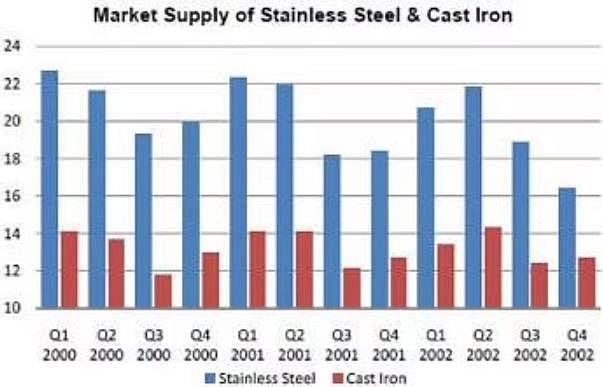
Q. In which of the given years was the market supply of Stainless Steel and Cast Iron, in million tonnes, the highest?
Analyse the graph/s given below and answer the question that follows.
The graph shows the market supply of stainless steel and cast iron over different quarters of three years in millions tonnes.
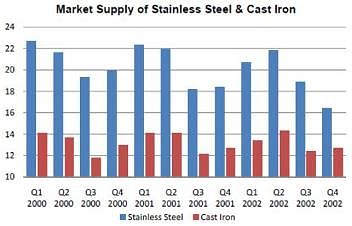
Q. From 2001 to 2002, the supply of Stainless Steel increased by approximately
Analyse the graph/s given below and answer the question that follows.
The graph shows the market supply of stainless steel and cast iron over different quarters of three years in millions tonnes.
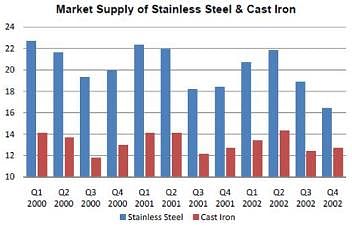
Q. In 2000, 29% of the supply of Stainless Steel and 31% of the supply of Cast Iron was from Imports. Approximately what percent of the total supply of Stainless Steel and Cast Iron was constituted of imports?
Analyse the graph/s given below and answer the question that follows.
The graph shows the market supply of stainless steel and cast iron over different quarters of three years in millions tonnes.
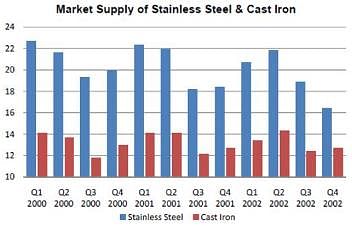
Q. In which quarter, as compared to the previous one, did the total supply of Stainless Steel and Cast Iron, in million tonnes, fall the most?
|
152 docs|327 tests
|



